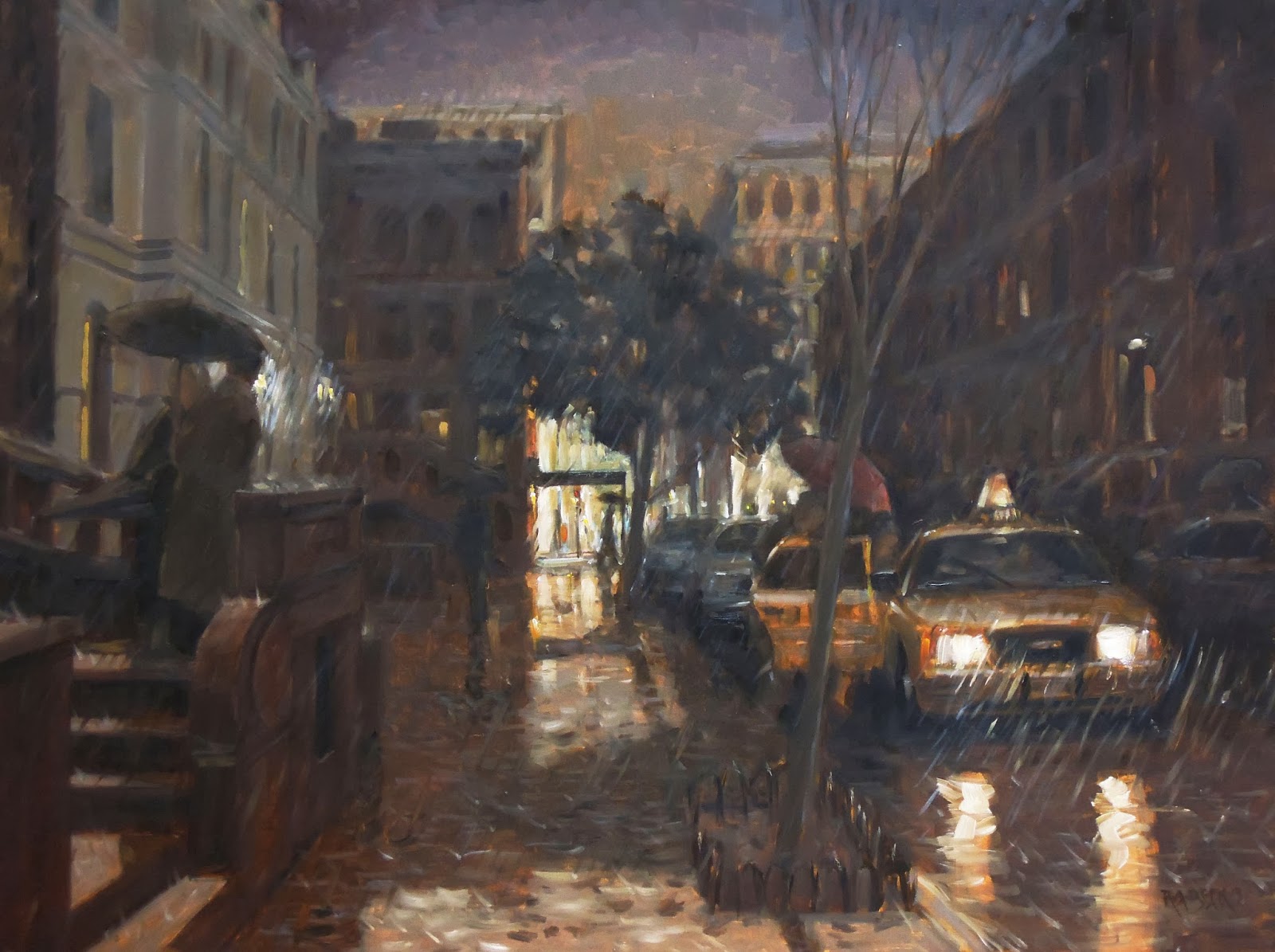Artists Choose their Favorites 2013 Robert Beck
Lambertville, New Jersey artist Robert Beck likes to paint from life, and not only the sort of life that a still life or a model in his studio might provide. He is drawn to real life situations, and has painted a hospital operating room, breakfast at a popular diner, parades and other active street scenes. In his own words, he says that he's always after the "succinct and perceptive description" of his subject, a goal that he achieves again and again.
Robert has chosen his two favorite paintings from 2013:

Manhattan Rain 24x30 oil on panel 2013
My year always begins with studio work. It is an opportunity to try things that have been lurking and percolating in my mind. Some of my winter live-painting is done indoors addressing subjects I don't need to waste summer weather on, but most of the time is spent on large images from my imagination. I've done plenty of frigid plein-air paintings so I feel I have that part of my career covered.
When working in the studio I try to incorporate two or three investigations into each painting. In the case of Manhattan Rain I wanted to revisit my attempts to describe atmosphere that speaks as rain (by revisit I mean that I did it once years ago, let's see if I can do it better now). Rain is not without challenge. I also wanted to capture that not really dark dome of lavender gray that passes for a city night sky. There is a distinct identity to the residential streets that lie between the commercial avenues of the Upper West Side that I hoped to have come through as well. The color harmony, the perspective, and the composition all worked in concert toward those goals. The painting is loose, so the viewer gets to manufacture her own involvement, and it doesn't have any missteps to cause distractions. It was my best studio painting in 2013.
Stanley Beal 16x16 oil on panel 2013
The majority of my work (I do roughly 150 paintings a year) is three-hour plein-air paintings focused on the places, occupations and artifacts of our time. The portrait of Stanley Beal was part of an essay of 16 images painted from life in Jonesport, ME this summer. I met Stanley because his wharf was the only spot on Beals Island where I could get phone reception. I wanted a portrait for the series and he was a perfect representative. There was a late-morning period during his long day when the work of running a lobster wharf slowed and he agreed to sit for me. Stanley talked a lot (unusual for Downeasters) including some heartbreaking moments in his life. The whole experience was intimate and moving; the 78 year-old fisherman and the painter. I got him in his place and time, and the portrait feels like the Stanley I know. It was a privilege to be there, and it wouldn't have happened if I wasn't a painter. Every time I look at this picture of Stanley I'm reminded of that, and feel very fortunate.
When I look at my paintings I'm not seeing the finished product as much as reliving my involvement in the creation. I'm going through the technical discoveries, accidents, chances, mistakes and solutions that happened while building the image, or I'm remembering my personal experience, as I do with the painting of Stanley. Often it's both.
It can be difficult to determine where a painting begins since some of the initial thoughts and influences can occur years before, and I'm working on it in my head before putting a panel on the easel. The process also continues past the last brushstroke. Sometimes I spend weeks looking at a painting after it is done, because my feelings aren't not finished with it - something inside me has to catch-up. It takes time before I can emotionally arrive at done, but when I reach that point I separate from it and I'm ready for another big investment.
When I'm painting an essay of images from life such as the one in Maine I usually do two paintings a day for a week or more. It becomes one long creative experience, more like working on separate sections of a larger image with breaks for food and sleep, and I don't really "see" the individual paintings until I'm home and have had a few days to find my feet. After each one (and usually while I'm eating) I write a few paragraphs about the circumstances surrounding the image. Between the words and the paint I end up with a trove of description that can be returned to later and refined to a clear and specific identity, which seems to be the grail for me. It is the succinct and perceptive description - the elegant visual phrase - that I admire in other artist's work, and I'm always looking for ways to encourage it in mine.
You can see more of Robert Beck's work at his website. You can see some of his terrific snow scenes in a previous post from 2012.
Robert Beck provides frequent updates on his Facebook page, including interesting remarks and insights about the making of his frequently posted work.




Comments
Post a Comment